|
First a little background - I was really impressed by the way the Puddle Duck Racer, David Routh's class racing design, took off, especially after Michael Storer offered plans for his racing version, the Oz PDRacer, for twenty bucks. It was obvious that people were ready for an easy to build class racer that would not break the bank.
What really surprised me was the expedition models that started to develop. Then when the PD3 sailed the entire course of the inagural Texas200, I knew there was another opportunity for a new design - an easy to build boat more suitable to the unique demands of the Texas200. But, I reasoned, folks would want something faster. And probably something that would allow a crewman as the consensus is going away from solo sailors (the PD Guys nothwithstanding) and toward tandem boats.
So I decided to approach Jim Michalak with a letter:
Jim:
Since reading Norm Wolfe's account of Raider, I have been thinking of commissioning something for the Texas200. This is a whole different event from Raid Finland. One of the things I have been considering is building a boat right on the beach before the event. Even if that were not the case, I would like something so simple that a bunch of them would be built and more or less raced over the course as a class. This is protected water, so a flattie is fine. I am thinking of something long and skinny not unlike Bolger's Light Schooner but maybe with balanced lugsails. Maybe a periauger rig with a third mast step for really windy conditions. It would carry a crew of two and be able to sleep them in the boat if needed, otherwise camping ashore would be the norm. No rowing should be required except in emergencies. Simplicity of build and speed downwind are the main criteria. Your regular leeboard will be fine - it would be up half the time and bumping occasionally when down. I would want to build it with an external chine log to encourage new builders. I would be open to folding it as Bolger did with the Folding Schooner, if you wanted to fool with that - it would sure make trailering simpler.
Chuck
Jim replied the next day - this is unusual for him as he normally thinks about things like this for a while. I had an idea he was pretty interested:
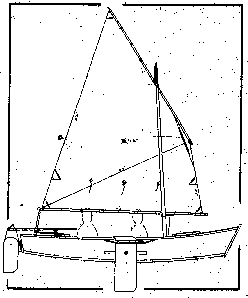
Mayfly 16
Chuck,
If you take a boat like Mayfly16, which I have featured in this issue of jimsboats.com, and stretch it to say 24' by adding a second cockpit with a mast "box" between the two cockpits, sort of like a Seapearl, then a bit wider say a 5' wide bottom, you ought to be able to sleep 4 in there. You could daysail up to 8 or more I guess. It would be pretty simple and still have the motor well in the stern. The sailrig ought to be two identicle lugs with the option to sail with just one mounted in the middle box, as you mention. It would be interesting and possible to do quick and dirty. If you try to sleep more than 4 on board you will have lots of problems I think. Either way I would carry some cheap small tents to pitch in the shore just in case. Just had a thought that we might add a small mizzen to give many other sailing options.
I did post a writeup about the Jon20 last year. You should find it at www.jimsboats.com/1feb08.htm
Actually that entire issue was devoted to it.
Well, he have seen a blast of real winter. The snow is melting but I think it will be weeks before boating. Usually we can get boating here about early March although you can't swim until June.
Jim
This was close and I almost told Jim to go for it. But I wanted it simple and cheap so I asked again about the beam and if we could't make it 4 feet. I wrote back:
Everything you have suggested is right in line with my thoughts except for one thing. That is beam. We are thinking this boat would be a two man vessel. More than that and we start to limit the number of boats because there is a limit to the number of idiots who would take part in this thing. Also it is one thing to have two fellas on a boat that get along with each other for a week, but make it three or four and the odds go down. This boat should be a two man boat. With that in mind, making the bottom a max of four feet wide allows us to cut all the bottom pieces the long way on the plywood. One thing to factor is that we need five gallons of water per man along with tents for sleeping ashore, food, other gear and a few pounds for tools and repair supplies. If it can't be done on a four foot bottom, so be it. I can live with it either way.
Jim came back:
You are right about the beam. Mayfly16 is 46" wide inside so a 4' sheet will span it. I guess if we put an 8' stretch on Mayfly it will be 23' long. Won't weigh too much. Given length, narrow, light weight, it might be really fast if you keep it on its feet.
I will make up a sketch in the next week and fax it to you
Jim
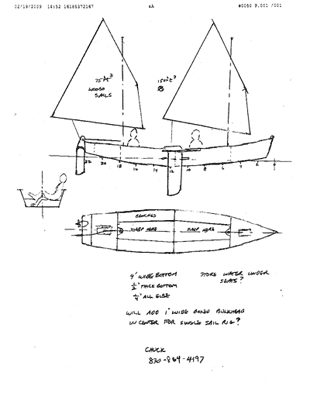
Jim's initial sketch - (click to enlarge)
Jim sent me a preliminary sketch and was quiet for a while. Then I saw this in his newsletter:
Laguna
DOWN IN TEXAS....
They started a "cruise", not really a race, 200 miles up the protected waters of the intercoastal waterway. They say the wind blows strong and from such a direction that you reach or run the whole way and usually in smooth water. The area is pretty unpopulated and in the several days it takes to make the run you must be self sufficient including taking all your food and water needed.
One participant wanted to build a boat for the event and started with a look at Raider. Raider was also made for a "race" but in the Baltic where the wind is not nearly so reliable, thus it was also meant to row well. The Raider crew always bunks on shore, in splendor, so carrying gear in the boat is not really required.
The Texas boat was to have a crew of two and it would best if those two could sleep on the floor of the boat although storage would be needed for a tent also. Plus all the rest for several days including a few hundred pounds of fresh water. So it would have to be different from Raider. No need for that somewhat elaborate V bottomed shape, either, since it was expected to be max hull speed reaching and running in smooth water. So a flat bottom was fine. CL also suggested the simplest possible construction, maybe even be able to build it on site in the days before the race.
I doodled some doodles and decided to try a lenthened version of Mayfly16, the prototype shown here by Tom Fulk:

If you're gonna lengthen it, might as well add 8' or so, the length of a plywood panel. I was asked to keep the bottom narrow enough to plank over with a single width of plywood, 4', like Mayfly16. The sail rig was also to be kept simple and need not be large given the usual strength of the wind there. My second or third doodle looked like this:
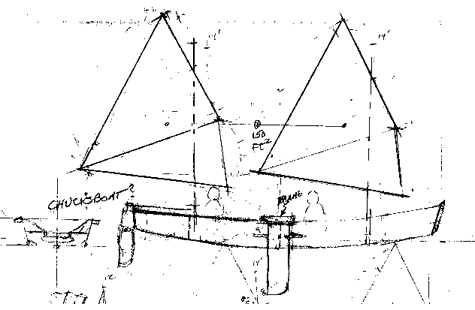
The two sails and masts are the same as my Ladybug rig, something CL already has on hand, at least one of them anyway. Then there is a plan to have the ability to mount a solo mast in the boat's center.
So in general we have a long skinny flat bottomed sailing skiff of the simplest sort of construction. There are two cockpits so the sailors can sulk and mope apart from one another on the long trip, no need for mutiny or worse. The cockpits are each 6.5' long so sleeping on the floor is possible. There are storage/buoyancy chambers fore and aft. They should help a lot in a knockdown but a boat with 13' of open cockpit can swallow a huge amount of water in a knockdown. One thing that might help a lot in such a situation is to tie large air filled fenders outside of the top wale to give the narrow boat broader shoulders to lift it when it goes sideways.
At first I gave it long bench seats like Mayfly16's but on second thought I changed to individual seats that cross the backs of the cockpits. On a trip this long you must be comfortable. These should be quickly removable to allow clearing for the sleeping spot. The bench seats simply can't allow a center aisle wide enough for sleeping. I might add that if the boat were used on occasion to take out a very numerous crew, say a family reunion, then I would suggest leaving the seats on shore and have all sit on the floor. Then again, if you are never to sleep in the boat you might install the bench seats, which can be somewhat complicated but usually provide the best comfort. Anyway, the side view cross section ended up looking like this:

I drew up the expanded panels and made a card model that looked like this:

It stern has my usual open well with a place for a small motor. I drew up the sail rig in more detail and got this:
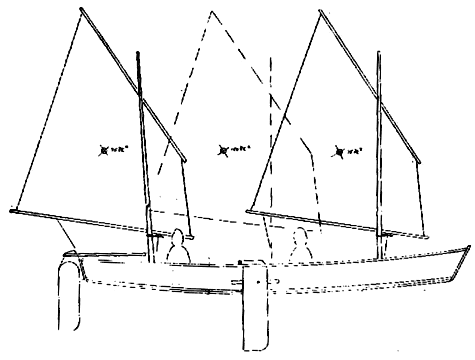
No real change here from the original cartoon but I've shown the single mast setup in dashed lines. The tiller of such a boat always bothered me. The masts are on centerline. The tiller has to end short of the mast of course to allow it to swing. So the skipper has to hand it back and forth to himself sometimes on tacks. I think what I show is the best approach, or at least the simplest. Any other rig would require some linkage or perhaps a large oddball tiller. This should work OK given the long stretches with no tacks required in the race.
About this time, with the design pretty much set, I made up a Hullform model which looked like this:
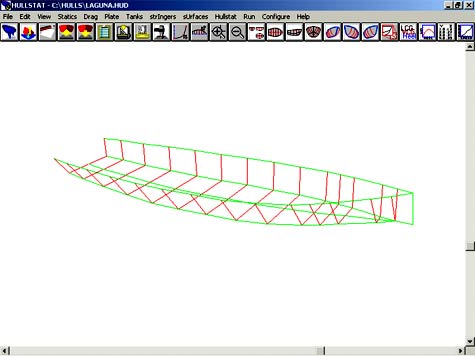
The program doesn't seem to allow slanted stems and transoms so it isn't exactly per the drawing. These are very good at scoping out displacement, although with such a simple design you can do OK with a quick hand calc. For example here, if the boat were loaded down to where its stem hits the water, what I would call the maximum displacement (although the boat could clearly take a lot more weight with ugly flow lines), then the waterline length would be about 21'. The maximum submerged cross section would be about 7" x 48" in area (draft times beam) which is 336 sq in which is 2.33 sq ft. So a "prizm" 21' x 2.33' would have a volume of 49 cubic feet. Boats like this almost always have a "prizmatic coefficient" of about .55, so I would expect the real boat to have a displaced volume, at 7" draft" of .55 x 49 which equals 27 cu ft of water. Water weighs about 63 pounds per cubic foot so that displacement amounts to 1700 pounds of displacement. The Hullform model predicts 2000 pounds displacement at 7" draft so perhaps the difference is partly because the side flare gives a bit more displacement and perhaps the hull is fuller in the ends than the norm. I think the higher coefficient is good in smooth water.
At this stage I could start a layout of the plywood panels. No need to make this boat heavy so I would call for a bottom of 1/2" plywood and maybe 1/4" plywood for all else, although some of you can't stand on a 1/4" ply deck. The total on first cut looks to be nine sheets of 1/4" and five sheets of 1/2". Usually 1/4" sheets weigh 25 pounds and 1/2" sheets weigh 50 pounds so the grand total would be 475 pounds. I would expect the completed hull to weight about that. So the boat will have a lot of capacity for the trip.
CL suggested that maybe several of these might "nest" together on a trailer. I don't see how any boats can nest together if they have any sort of deck structure. You might be able to stack two of these on a special trailer, as I have seen racing sailboats like Y Flyers stacked. But how are you gonna unstack 500 pound hulls without a lot of help? But it could be done.
SO THERE YOU HAVE IT...
Jim Michalak
_________________________
In conclusion: I am delighted with Jim's design. Sandra felt it should be named "Laguna" after the body of water that we sail in for the first two days of the Texas200. So Laguna it is. By the way, plans are available here:
https://www.duckworksbbs.com/plans/jim/laguna
My goal is to get at least five of these boats built for the next Texas200. I have a couple of committed builders, including myself, and a few interested. I have decided to refund the plan price to anyone who build's a Laguna before the 2010 Texas200. If we can get 5 boats on the water next year, it might be interesting to rotate crew each day. That maximizes what we learn from each other and minimizes too much togetherness. What happens if one boat drops out? I think that these boats should be able to bring enough spares to keep all the boats going. That is what the Puddle Ducks did this year. - Chuck
***** |

